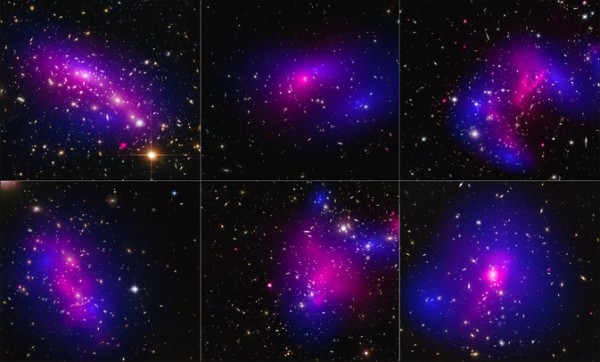No Mirror Universe? Colliding Galaxies Reveal Secret Properties of Dark Matter
| Ana Verayo | | Mar 27, 2015 09:39 AM EDT |
(Photo : NASA and ESA) Images of six different galaxy clusters taken with NASA's Hubble Space Telescope (blue) and Chandra X-ray Observatory (pink) in a study of how dark matter in clusters of galaxies behaves when the clusters collide.
New research reveals how dark matter can behave in a cluster of galaxies, especially when these clusters collide with each other. These findings offers new insight into how deeply complex dark matter's nature is from what is currently believed.
Scientists used data from NASA's Hubble Space Telescope and the Chandra X-ray Observatory when they discovered that dark matter apparently doesn't slow down when it interacts or collides with itself. Researchers now believe that since it rarely interacts with itself, this can narrow down dark matter's characteristics.
Like Us on Facebook
Scientists believe dark matter makes up most of the mass of the universe. It's not visible since it doesn't reflect light or even absorbs or emits light.
Dark matter can only be detected indirectly by measuring how much it warps space, a phenomenon made visible by gravitational lensing that magnifies and distorts light due to dark matter's powerful gravitational forces.
In this study, Hubble mapped the distribution of stars and dark matter after a stellar collision detected due to a gravitational lensing effect from the background light of the collision. Chandra detected its X-ray emissions and confirmed its presence from the gas cloud collision.
Galaxy clusters are made up of galaxies, gas clouds and dark matter. When they all collide, the gas clouds surrounding the galaxies crash into each other and either slow down in circulation or ultimately stop.
The galaxies, however, aren't significantly affected by the collisions since they possess large gaps between them and the stars.
The team discovered that dark matter is less likely affected by these collisions and isn't even slowing down. This leads to the idea that dark matter doesn't totally interact with visible particles surrounding it, which was the previous theory.
If dark matter were to collide into other dark matter during the collision, the movement of the galaxies could have shifted significantly.
This discovery has been pivotal in narrowing down the properties of dark matter. Particle theorists now possess a smaller set of unknowns to work with when it comes to building their dark matter models.
Dark matter could possess rich and complex elements and properties but there are several other interactions in theory. These latest results confirm that dark matter doesn't slow down during collisions even if there are powerful frictional forces around them.
This study was published in the journal, Science.
TagsColliding Galaxies Reveal Secret Properties of Dark Matter, dark matter, hubble telescope, chandra telescope, NASA, dark matter collisions galaxies cluster mirror universe, galaxies collisions
©2015 Chinatopix All rights reserved. Do not reproduce without permission
EDITOR'S PICKS
-

Did the Trump administration just announce plans for a trade war with ‘hostile’ China and Russia?
-

US Senate passes Taiwan travel bill slammed by China
-

As Yan Sihong’s family grieves, here are other Chinese students who went missing abroad. Some have never been found
-

Beijing blasts Western critics who ‘smear China’ with the term sharp power
-

China Envoy Seeks to Defuse Tensions With U.S. as a Trade War Brews
-

Singapore's Deputy PM Provides Bitcoin Vote of Confidence Amid China's Blanket Bans
-

China warns investors over risks in overseas virtual currency trading
-

Chinese government most trustworthy: survey
-

Kashima Antlers On Course For Back-To-Back Titles
MOST POPULAR
LATEST NEWS
Zhou Yongkang: China's Former Security Chief Sentenced to Life in Prison

China's former Chief of the Ministry of Public Security, Zhou Yongkang, has been given a life sentence after he was found guilty of abusing his office, bribery and deliberately ... Full Article
TRENDING STORY

China Pork Prices Expected to Stabilize As The Supplies Recover

Elephone P9000 Smartphone is now on Sale on Amazon India

There's a Big Chance Cliffhangers Won't Still Be Resolved When Grey's Anatomy Season 13 Returns

Supreme Court Ruled on Samsung vs Apple Dispute for Patent Infringement

Microsoft Surface Pro 5 Rumors and Release Date: What is the Latest?










